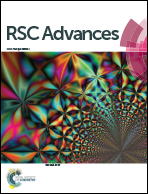Hybrid cholesterol-based nanocarriers containing phosphorescent Ir complexes: in vitro imaging on glioblastoma cell line†
Abstract
Recently the use of phosphorescent heavy-metal complexes in bioimaging techniques has been a promising research field and has been attracted increasing interest. Among these, phosphorescent iridium(III) complexes have shown many photophysical characteristics that made them promising candidates for fluorescence probes. In this study an innovative copolymer consisting of cholesterol, a natural component of biological membranes, and the well-known biocompatible Polyethylene (PEG), has been synthesized. Cholesterol–PEG amphiphilic copolymer has been used to form novel nanocarriers characterized by the incorporation and/or linkage of the phosphorescent iridium(III) derivatives through covalent or non-covalent interactions. Finally the nanocarrier's surface has been functionalized with the peptide chlorotoxin (Cltx), a targeting agent selective for glioblastoma cells (U87MG). The so obtained targeted water soluble nanocarrier has been tested for in vitro imaging on the glioblastoma cell line and has shown no toxic effect on cells.


 Please wait while we load your content...
Please wait while we load your content...